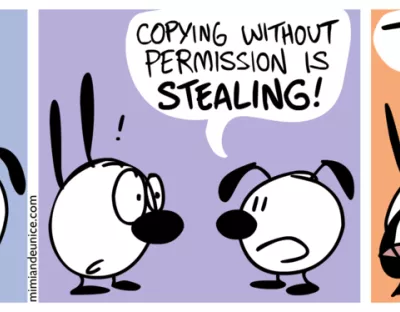By Angelica Risquez.
Reading time: ~6 minutes.
Featured Image Source: 'What if assessment was designed around me?' Bryan Mathers on Flickr (CC BY-ND 2.0)
In part 1 of this post, I referred to recent concerns about the academic integrity of ‘take-home’ exams as a result of the sudden shift to online teaching and learning. Academic integrity is something that we often pay attention to ad-hoc, particularly when plagiarism cases flare up while we go through our ‘corrections’. You may be now battling with creating online resources and supporting confused students, yet − as prevention is better than cure − early attention to this issue will reap its benefits in a few weeks from now.
In this post, I propose three key elements for your consideration:
1. Promote a culture of academic integrity
Highlight information about academic integrity and plagiarism (Appendix 4 of the Student Handbook) directly in your Sulis/Moodle site for your students. There, plagiarism is presented in stern terms as a ‘serious offence under the Code of Conduct’ and defined as:
Copying someone else’s work (whether or not in the public domain) and passing it off as one’s own, or inappropriately resubmitting one’s own already graded work and passing it off as original.
But more importantly, clarify directly with them, and discuss at length, what academic integrity means in the context of your module and assessment, and why this is important to you and to them. Be realistic: assume that students are going to check with each other and the internet when completing your assignment. So, if your assessment is to be ‘open book’, what does that mean? What sources are they allowed to check? How can they reference them? How should they acknowledge their sources (which may include people consulted or legitimate groupwork)? You can even consider organising a collaborative activity for students to contribute to an ‘honor pledge’, as a learning contract that states their expectations and responsibilities around academic integrity. Then, when creating an assignment in Sulis, you can select ‘Add honor pledge’, so students will be presented with the screen below before they are able to complete their submission.

If you are using the Test & Quizzes tool to facilitate an online test through MCQs for example, you will also have the option to require students to confirm an honor pledge as below:

2. Work to develop academic writing skills
There is an implicit assumption that if students understand what plagiarism is and hold ethical views around it, then they will be able to recognise it and avoid it in practice. Challenging this supposition, UL-based research (Risquez, O'Dwyer and Ledwith, 2013) demonstrated the mismatch between students’ self-reported views on plagiarism with their ability to recognise and avoid it in practice. So students’ understanding and awareness of academic breaches is necessary but not sufficient, and experiential learning on academic writing is essential.
The Regional Writing Centre at UL offers a free and friendly place for all students (undergraduate and postgraduate) to come and address any aspect of their writing, helping them to develop strategies to become more confident, critical and autonomous writers. The Writing Centre is also available to staff who are interested in developing their students' writing.
The UL Library also offers a series of online tutorials including Cite it Right, the basics of referencing, Citing and Referencing UL Harvard Style (interactive tutorial), Library Guide to Referencing and Know Your Sources. To support students at all levels, it runs information and digital literacy sessions (www.ul.ie/library/events). Encourage your students to attend. Equally, talk to your faculty librarians, Peter Reilly (KBS), Pattie Punch (AHSS, IWAMD), Micheál O hAodha (Science & Engineering) or Liz Dore (EHS) if your student group would benefit from some guidance.
There is also a wealth of open educational resources for your students to work either independently or with your assistance. And it does not have to be too boring either! For example, Ryerson University (Toronto) just launched a new gamified academic integrity resource to teach students about key concepts in academic integrity called Academic Integrity in Space, where students go head-to-head with Captain Plague and the League of the Unearned.

Watch video: Ryerson University gamified academic integrity resource, Academic Integrity in Space
Also, the Open University has an online course, Developing Good Academic Practice, that is published under a Creative Commons license. You can download the materials in a variety of formats (see right- hand side panel) if you want to adapt.
3. Play close attention to your assessment design
Probably the most crucial element for consideration, I believe, relates to the design of your assessment. If you are asking students to research generic questions that are easily sourced online, and you tend to repeat your assessment year on year, you are planting the seeds for trouble. However, if your assessment is authentic, relates to the students’ immediate experience, and offers some choice, you are more likely to engage students in a more meaningful way. Also, pay attention to the amount of assessment required from students in the module and across the programme. Plagiarism due to desperation reveals perhaps lack of planning on the students’ part, but also highlights the huge amount of pressure that students are under due to multiple assessment requirements and our compulsion to assess every single learning outcome.
If you are planning on using the Sulis Test & Quizzes tool (or an equivalent alternative in Moodle), then you are advised to create context-specific/topical questions tied to recent events or material. Processual questions and reflective answers can go a long way to engage students more deeply than simple MCQs. As recommended in ASSESSMENTS: Making your exam work as a take-home assessment':
Questions will be less vulnerable to plagiarism if what is being assessed is the route to a judgement. Where there is no single right answer, it is harder for students to lift material from the internet. For example, questions could allow multiple ways of calculating a numerical answer (with marks awarded for the process), or questions could require students to present a well-argued personal point of view.
In the third and final part of this post on Friday, I will talk about Turnitin do’s and don’t as a plagiarism detection tool, and what to do when, despite our best efforts, plagiarism cases arise.

